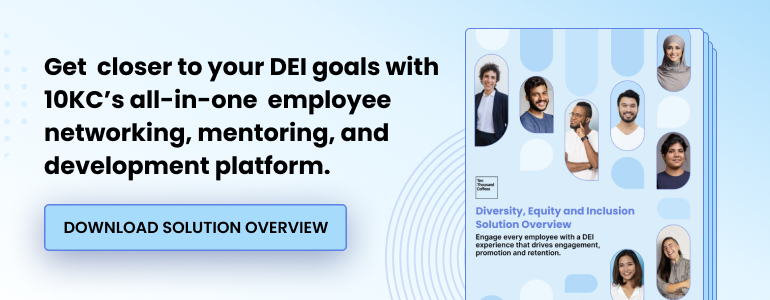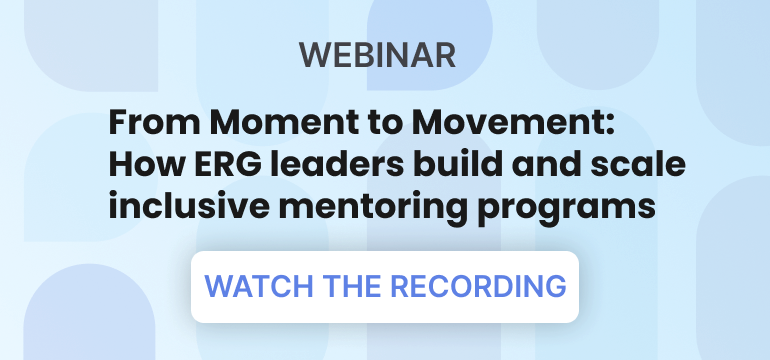Despite awareness of DEI's importance, it’s still a challenge to facilitate valuable impact. In order to create meaningful change, it’s critical for HR, DEI, and business leaders to build safe spaces for underrepresented employees. Employee resource groups are one key strategy for providing these opportunities—they play an important role in making diversity and inclusion programming a part of everyday work life.
Let’s unpack how employee resource groups empower underrepresented employees to thrive, becoming a powerful tool in your company's DEI strategy.
What does ERG stand for?
ERG stands for Employee Resource Group—volunteer, employee-led communities centered around shared identities or interests. These groups foster belonging and amplify underrepresented voices. 90% of Fortune 500 companies have ERGs, and 66% of employees say ERGs build a sense of community.
What does an Employee Resource Group (ERG) look like in practice?
In practice, ERGs take many forms and unite employees around meaningful aspects of their identity or lived experience. While employee-led, they’re typically supported by the organization and play a key role in advancing diversity, equity, and inclusion (DEI) by building community, driving dialogue, and influencing company culture.
Because every ERG serves a different group of employees, they will each have a different mission and engage in different activities. However, they typically share a common goal: to create opportunities and elevate the work experience for employees within their group.
ERGs are meant to be formal workplace initiatives. In order for them to be effective, they are often sponsored by an executive. This is someone who isn’t necessarily a member of the group but supports the group by using their influence to promote the group's interests, serving as a line of communication with senior company leaders and helping the group access the resources they need to make an impact.
While ERGs are facilitated by the organization, participation in ERGs should be voluntary. This means companies can encourage employees to join groups as leaders and members but shouldn’t force people to participate.
ERG examples
ERGs can come in many different shapes and forms. They’re typically identity, affinity, or even interest-based. Some common examples of ERGs you’ll find in organizations include:
- BIPOC employee resource groups
- LGBTQ+ employee resource groups
- Women employee resource groups
- Parent employee resource groups
In some companies, these groups aren’t necessarily referred to as employee resource groups but they serve the same purpose. Your company may have a different lineup of resource groups than other organizations, as ERGs should be reflective of the needs of your employees.
The role of ERGs in the modern workplace
ERGs have a rich history, serving a critical role in organizations for several decades. Their impact continues today, as they've evolved to meet the needs of the modern workplace.
The good news? The number of companies with ERGs continues to grow.
As of 2021, 40% of all companies have ERGs—9% more than the previous year. A more recent Workhuman study found that as of 2024, about 41.3% of employees report having ERGs at their company.
However, despite the growth, over half (68%) of employees are still unfamiliar with ERGs. Among those who are familiar with them, only 55% report that their employer offers one, meaning there is still tremendous opportunity for employers to leverage ERGs in the workplace, particularly when it comes to moving the DEI needle.
The link between ERG and DEI
Employee resource groups are traditionally founded on the need for better diversity and inclusion within organizations. The first known ERG was the National Black Employee Caucus at Xerox, created in response to racial tensions in the 1960s. Soon after, the first LGBTQ+ ERG was founded at Hewlett-Packard in the late 70s.
By creating opportunities for underrepresented employees to engage with individuals of similar backgrounds and their allies, ERGs create psychologically safe spaces for employees to thrive. When effective, ERGs can also increase diversity among employees, foster equitable workplaces, and boost inclusion, helping organizations get one step closer to their DEI goals.
The importance of ERGs for reaching DEI goals
DEI goals and mandates are becoming increasingly commonplace among organizations. ERGs are a powerful tool for reaching them. The proof? As many as 90% of businesses that have ERGs find that they’re the key to successfully promoting DEI within their organization.
So let’s talk about the benefits of ERGs, and the many ways they help companies reach their DEI goals.
Benefits of ERGs for organizations
Here are a few ways ERGs contribute to an effective corporate DEI strategy.
1. ERGs encourage diversity in promotions and recruitment
One of the most common DEI goals is increasing representation, particularly in manager and senior leadership roles. ERGs can help organizations set up diverse internal talent for promotion and attract diverse external candidates.
For example, hiring managers and leaders often rely on trusted informal networks to promote, recognize, and recruit talent. However, with underrepresented employees often excluded from those networks, it can be difficult for them to gain exposure to career advancement opportunities. Unconscious affinity biases can, unfortunately, create barriers that can make it a challenge for underrepresented employees to access the same networks as their peers.
Instead of solely relying on biased networks, ERGs can provide targeted opportunities—such as learning and development or mentorship—for their members that help level the playing field and open the door for diverse talent.
2. ERGs encourage inclusive business practices
You’ve likely heard the saying that there’s strength in numbers. ERGs are proof that the saying is true.
It’s difficult for employees to speak up when they feel isolated or alone. ERGs give employees a collective voice, so they can share their feedback and speak up when decisions and policies are biased or not inclusive.
For example, an accessibility-focused ERG may be able to identify concerns with accessibility in company infrastructure. On the other hand, an LGBTQ+ ERG might be able to highlight employee benefits that don’t meet the needs of non-binary employees and their families.
Even with the best of intentions, sometimes things can be missed. ERGs provide employees with a path to effectively advocate for their needs. It also creates a culture of trust and transparency within the organization and helps the company better support diverse talent.
3. ERGs boost employer brand
A Salesforce report found that 55% of organizations believe ERGs support their recruiting and hiring efforts while 75% believe that they support their company retention efforts. This isn’t entirely surprising when you consider the different ways that ERGs contribute to your employer brand.
These include:
- ERGs highlight diversity: When potential candidates see that your organization offers an ERG for a group that they identify with, they’re more likely to feel like they could belong at your company.
- ERGs encourage community engagement: ERGs often partner with or support local organizations which boosts your visibility as an employer within the community.
- ERGs show commitment to inclusion: As ERGs are employer-supported, it shows current and potential employees that your company is providing opportunities for networking and professional development for employees of all backgrounds.
The impact of ERGs on employee perception of an organization is even more prominent among younger workers. An HBR study found that 70% of respondents who were 18 to 24 years old and 52% of respondents between 25 and 34 would be more likely to apply for a role at a company that had ERGs.
4. ERGs promote innovation and agility
ERGs encourage networking between employees of similar backgrounds. However, these employees also tend to work across a wide range of departments and levels within the company. By boosting employee networks across the organization, ERGs encourage collaboration and diverse perspectives, boosting creativity and innovation.
The networks created by ERGs also provide a platform for companies to spearhead coordinated, rapid responses to major social events that impact their employees. For example, when racial protests swept across the US in 2020 due to George Floyd’s murder, Salesforce was able to rapidly set up a Racial Equality and Justice task force to address four key areas—people, philanthropy, purchasing, and policy. It was Salesforce’s employee resource group for Black employees, BOLDforce, that provided guidance to the task force.

Benefits of ERGs for employees
ERGs don’t just benefit your organization– they also provide employees with support, community, and a sense of belonging, making work more fulfilling.
1. ERGs boost employee belonging and connectivity
Belonging is closely tied to employee performance, engagement, and turnover. While hybrid, remote, and global organizations come with many benefits, they can take away from employee connection and belonging—with as many as 40% of employees reporting feeling isolated at work.
This can be particularly true for underrepresented talent since they may not as easily encounter peers they identify with. ERGs help create an inclusive environment that ensures underrepresented employees feel like they belong. It creates a safe space where employees can find a community they connect with and bond over shared experiences.
2. ERGs provide equitable opportunities for networking and career development
An employee's network is a high predictor of performance—even more than personality, intellectual ability, experience, and education. However, creating opportunities for employee networking is often easier said than done in large organizations. And when employee networks are left to chance, it’s often underrepresented employees that get left behind.
ERGs naturally build up employee networks by connecting employees of similar backgrounds. But most ERGs can take networking and professional development even further, by creating intentional networking opportunities unique to their members. Scotiabank, one of the largest banks in Canada, is a great example of this. The Scotiabank Black Employee Network created a mentorship program specifically pairing Black executives with Black directors for mentorship and sponsorship to develop high-performing BIPOC leaders.
3. ERGs increase job satisfaction
With employees spending 40 or more hours a week in the workplace, they want to feel happy and supported. Yet, a recent report found that employee satisfaction has plummeted as low as 22%. The same study found that feeling safe and included and opportunities for growth were top contributors to job satisfaction.
By providing networking opportunities and increasing connectivity, ERGs can help increase job satisfaction in more ways than one.
How ERGs drive impactful mentorship programs for underrepresented employees
Mentorship drives professional and personal growth. However, we know that diverse and underrepresented employees tend to fall behind the curve when it comes to having mentors and sponsors. For example, only 5% of black employees have sponsors compared to 20% of their white peers.
ERGs can bridge that gap.
Many ERGs facilitate structured and formal mentorship programs for members. But these groups themselves also serve as organic network builders. By hosting events and activities, ERGs naturally help broaden professional networks. This opens the door to informal and formal mentorship opportunities that these employees may have otherwise never been exposed to.
Connecting employees of similar backgrounds also aids in facilitating mentorship relationships that allow employees to feel safe and comfortable. For example, women often prefer to have female mentors. An ERG can help match female-identifying mentees with female-identifying mentors with similar goals and interests through a women’s mentorship program.

Examples of companies with employee resource groups
With hundreds of companies hosting ERGs, there are many great examples we can learn from. Here are some employee resource groups that are making an impact.
ERGs at Accenture
Global professional services company, Accenture offers well over 22 ERGs to its employees, with over 30,000 members to create a more diverse, innovative, and vibrant culture.
In a webinar with 10KC, Anissa Thompson, Managing Director of Software and Platforms shares the value of ERGs in elevating underrepresented talent groups and bridging networking and mentorship gaps within the organization.
“At Accenture, we not only have employee resource groups (ERGs), but we make sure they have the support they need to be able to thrive, and the right access to leadership…we need different people to access those important networks.” - Anissa Thompson, Managing Director of Software and Platforms
WATCH THE WEBINAR: How Companies Can Create Supportive Workplaces for Black and Underrepresented Talent
GE Women’s Network
GE’s Women’s Network has been around for over 20 years, fostering the growth and development of women and promoting DEI across the organization. They host events, workshops, mentoring, and networking activities both within GE and in partnership with local organizations to provide resources for women employees.
The ERG not only supports internal employees but also provides mentorship and scholarship opportunities to elevate women working in engineering and STEM.
Spring Health Black Employee Coalition
Spring Health identified much higher rates of attrition among Black and Hispanic/Latino employees. So, they hosted listening sessions with their ERG, the Black Employee Coalition, for Black and Hispanic or Latino team members to hear directly from these employees about their experiences.
Mentorship was a key need that employees identified. The company quickly launched a pilot mentorship program with additional development sessions, which proved successful. With the help of 10KC, they were able to scale the program significantly to make mentorship accessible to the majority of their employees. Attrition rates from their diverse team members have since declined from 32% to 15%.
“Myself and the co-leaders of one of our ERGs, the Black Employee Coalition, hosted listening sessions for our Black and Hispanic or Latino team members [...] We wanted to hold spaces for team members to share what was going well, and what wasn’t going well to ensure that we can retain this great talent.” -Michelle Rojas, Director of DEI & People Business Partner, Spring Health
CHECK OUT THE CASE STUDY: How 10KC Helped Spring Health Scale Mentorship and Decrease Attrition of Diverse Talent by Over 50%
Coupa Empower
Empower at Coupa, the company's ERG focused on supporting women, launched a mentorship initiative with 10KC in direct response to feedback from the sales team. These women sought greater opportunities for professional development, networking, and career advancement. The initiative has garnered strong support from male allies, increased visibility for women in male-dominated teams, and fostered a robust network of connections.
“What I love, among many things about Coupa, is that we really give robust support to our employee resource groups. We encourage employees to join the spaces that we make, and we fund our employee resource groups.” - Gina Tesla, VP, Coupa Software,Sustainability, Social Impact, and DEI
READ MORE: 10KC Innovator: Championing Women’s Mentorship at Coupa with Gina Tesla
Black@ Airbnb
Black@ Airbnb is one of 19 employee resource groups at the popular vacation rental company, supporting Black employees and allies. According to the official Instagram page, their goal is to provide a safe meeting space for Black employees and allies to discuss racial and ethnic diversity in recruitment, retention, and community efforts at Airbnb.
They’ve seen so much success, that Black@ Airbnb has taken steps to support other tech companies with running similar ERGs within their organizations with manuals and guides.
5 steps to creating effective ERG programs
Employee resource groups are a valuable tool for promoting DEI in your organization. However, an effective ERG goes beyond simply having ERGs.
Here are some simple steps to create ERG programs that drive your DEI objectives further.
1. Gather data to determine ERG needs: ERGs are for your employees. Look to employee data and feedback to understand what types of ERGs would be the most valuable for your team.
2. Find volunteer leaders: In some instances, employees may step up to the plate themselves. However, you may need to educate employees and encourage potential leaders to volunteer.
3. Determine goals and governance structure: ERGs are not a free-for-all. They should support employee and organizational goals. The most successful ERGs have clear missions and governance structures to help guide activities and initiatives.
4. Offer organizational support and resources: ERGs cannot exist without company support. Executive sponsors can help connect employees with senior leaders while access to resources can help ERG leaders carry out activities that make an impact.
5. Provide additional networking opportunities: ERGs are only one facet of expanding employee networks. Organizations should provide employees within these groups with access to mentorship software and other resources to equitably expand employee connections.
.png)
Employee resource groups FAQs
What is an ERG in DEI?
An employee resource group (ERG) is a diversity, equity, and inclusion (DEI) initiative geared toward creating career opportunities and networks for employees of underrepresented backgrounds.
By providing a safe space for employees to connect with peers of similar experiences, interests, or backgrounds, ERGs encourage employee connectivity and belonging in the workplace while helping organizations reach their DEI goals.
What does ERG mean in equity?
Employee resource groups (ERGs) are formally-supported groups within a company that facilitate equitable opportunities and workplaces for employees of different backgrounds. ERGs play a key role in equity in the workplace.
How many companies have employee resource groups?
An estimated 90% of Fortune 500 companies have ERGs. When considering companies of all shapes and sizes, approximately 41.3% of employees report having ERGs at their company. However, as more companies recognize the value of ERGs in reaching their DEI goals, they are quickly becoming more popular among organizations.









.png)